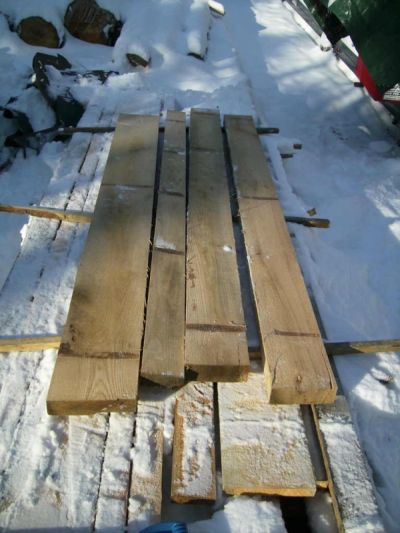Question
I have some 2" red oak planks that have been air-drying for about 1 year. The attached picture show 4 of these planks. One of my lumber customers wants to use some of this oak to construct some furniture (tables). Is it possible to build furniture from this oak without kiln drying? If so, what is the minimum time the lumber would have to dry indoors to be usable? I have now moved all the planks into my basement in a stickered pile to thaw them out.

Forum Response
(Sawing and Drying Forum)
From contributor A:
The moisture will be about 12 % MC, so it is too wet for indoor furniture. It will likely shrink about 1.5% MC as it dries and may also warp. You also could have powderpost beetles, so you need to heat the wood to kill them. They will not show up now, but will show up when the wood is warm for a few weeks or more. I would not suggest that this wood be used without kiln drying.
If your customer needs to work the wood immediately, then those boards aren't ready. However, if he can wait a little while, and put them inside, they should be ready inside 6 months. American craftsmen have been building furniture out of air dried lumber for over 400 years. If you know what conditions are required, it's not a problem at all. And, the beautiful colors of walnut and cherry are much more brilliant when not introduced into a kiln environment.
Although contributor C indicates that the wood is air dried, it is actually further dried at room temperatures, which is also the way lumber was dried by people 200 years ago. Today, we also air dry and then dry it in a kiln in a few weeks rather than wait for it to air dry at room temperature.
The phrase "air dried" has the connotation of 20% MC (+ or -), so it would not be fair to state that furniture was built with air-dried wood. If we redefine the phrase to mean that wood that has been air-dried will always be called air-dried, then even the kiln-dried wood used for the past century could be called air-dried wood.
I began working with my own sawn lumber as an experiment, because I was having difficulty finding consistent quality kiln dried lumber in the Chicagoland area. There are many, many suppliers around here, but you might (or might not!!) be surprised at how many times I'd resaw a 12/4 slab for bookmatched doors, only to find out I have some real expensive firewood. I now always make sure I stay ahead of my wood consumption rate by continually milling logs of the hardwood I use the most. That way, I rarely find myself needing to pay a visit to the hardwood store, unless it's something I don't use a lot.
Thanks for all your information at this site, also. I don't post frequently here, but I've been a daily lurker for several years now, and have learned quite a bit about sawing and drying lumber. When the economy improves, I will be expanding my business to sawing and drying quality lumber and slabs, with the furniture maker in mind.